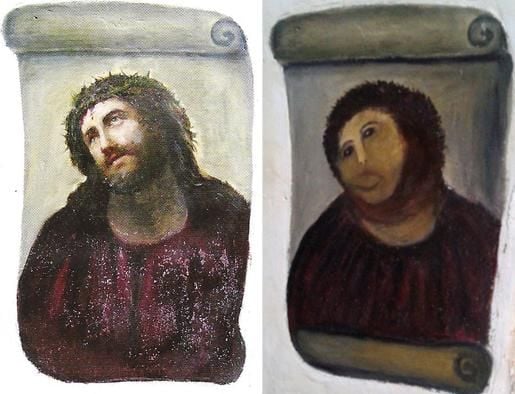Statue of St. George Undergoes ‘Unrestoration’ to Salvage Botched Paint Job
A 2018 restoration attempt left the 16th-century statue looking like a cartoon character
/https://tf-cmsv2-smithsonianmag-media.s3.amazonaws.com/filer/d0/b0/d0b038b0-96f1-477b-ad86-22a227af8ed2/3444.jpg)
When a botched restoration attempt of a 500-year-old sculpture of St. George in northern Spain went viral last summer, commentators couldn't resist weighing in: The well-meaning paint job, many pointed out, made the wooden statue look more like Tintin than a legendary dragon slayer.
Thanks to a roughly $34,000 USD “unrestoration” project, the statue—housed at St. Michael’s Church in the northern Spanish province of Navarra—has resumed a semblance of its original, 16th-century appearance. As Palko Karasz reports for The New York Times, experts from the local government’s culture department stripped the sculpture of its showy paint layers, assessed damage inflicted by the use of materials and processes “completely incompatible with the restoration of works of art,” and largely restored the walnut wood saint to his pre-2018 state.
But while Carlos Martínez Álava, head of the historic heritage department, tells the Guardian’s Sam Jones that the statue “has the same colors [seen] before last year’s extremely unfortunate intervention,” the fact remains, he says, that “we’ve lost part of the original paint along the way.”
Martínez Álava adds, “The bits of paint that were lost have been filled in and from a distance it all looks the same. But when you get up close, you can see very clear what’s original and what’s not.”
The initial spruce-up was reportedly conducted by a local handicrafts teacher untrained in the art of restoration. According to a statement by ACRE, Spain’s national organization of professional art restorers, the artist applied several layers of plaster, repainted the figure, and sanded its surface, effectively erasing the entirety of its “historical footprint.” The original artist had used a unique polychrome technique. According to London’s National Gallery, Spanish sculptors of the 16th and 17th centuries carved their statues and covered them in white gesso but were prohibited from actually painting the figurines, which were later gilded and refined by specially trained artisans.

In a statement posted to Twitter soon after the story broke, Koldo Leoz, mayor of Estella—the town where the statue has long stood in a church alcove—wrote that he did not doubt the goodwill of either the artist or the pastor who commissioned the work, but that nevertheless the effort had resulted in an “irreparable loss.”
Agence France-Presse notes that the local parish, which acted without the authorization of the region’s heritage institution, and the individual responsible for the work both faced steep fines for their role in the fiasco; they will both have to pay around $6,840, each.
The mayor, for his part, told the Guardian that Estella did not enjoy the boost in publicity associated with the restoration. “We don’t want to attract visitors because of the poor treatment of our heritage,” he said. “We haven’t publicized it and nor will we.”
Comparatively, the Spanish town of Borja was able to capitalize on its notoriety after a 1930s fresco of Jesus titled “Ecce Homo” received a restoration that left the religious figure more monkey than man. Since the 2012 incident, the painting has not only inspired memes, and one comic opera, but also drew tourists to the town, which now welcomes four times the number of visitors seen before the “restoration.” Cecilia Giménez, the amateur painter who worked on the fresco, became an internet sensation, managing to sell an original work on eBay for around $1,400.
Fernando Carrera, a spokesperson for ACRE, tells AFP the St. George sculpture’s pastel makeover is just “the tip of the iceberg of so many cases that don’t appear in the press.” Indeed, it’s worth noting that the story was just one of several botched restoration attempts to come to light last year: In September, for example, a local shopkeeper painted a trio of 15th-century religious figures in bright shades of fuchsia, turquoise and magenta, leading ACRE to once more denounce “this continued plunder in our country.”
As Carrera concludes, “There is a problem in management of Spain's historical heritage.”
/https://tf-cmsv2-smithsonianmag-media.s3.amazonaws.com/accounts/headshot/mellon.png)
/https://tf-cmsv2-smithsonianmag-media.s3.amazonaws.com/accounts/headshot/mellon.png)